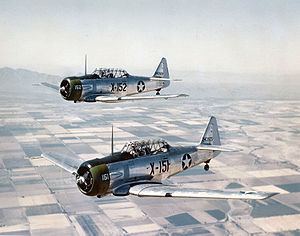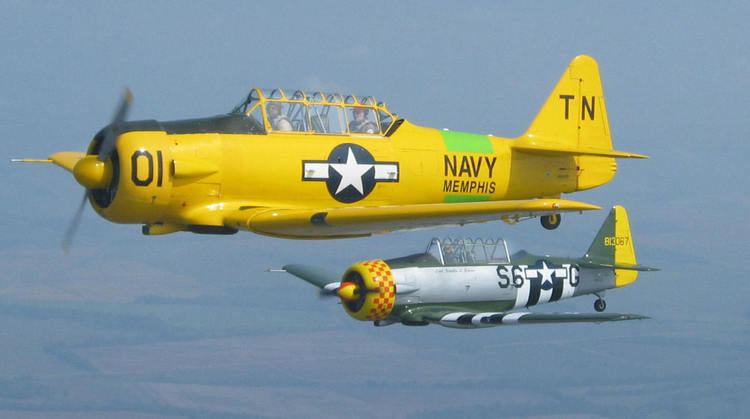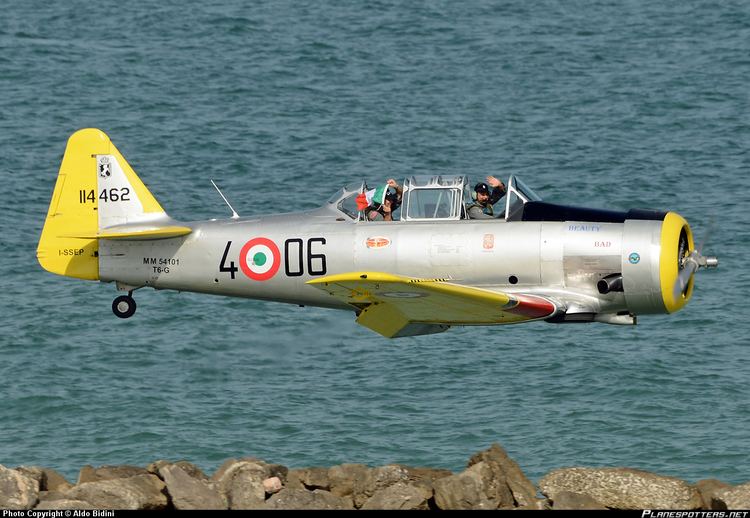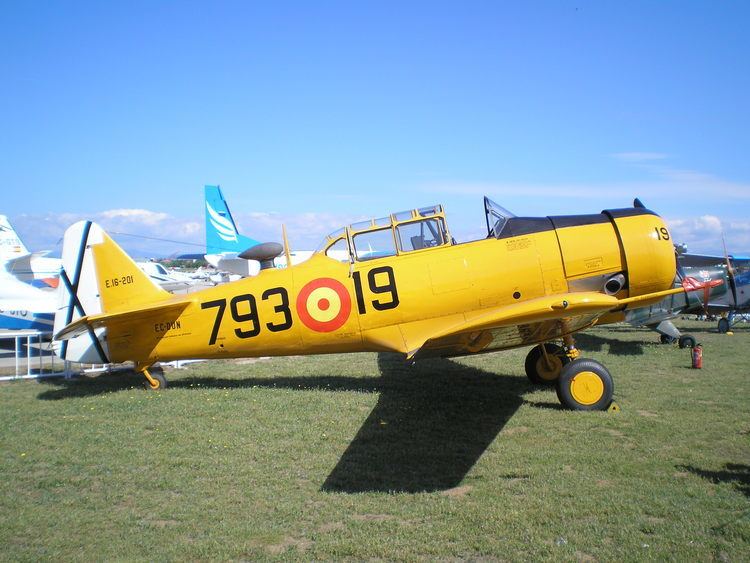Top speed 335 km/h Length 8.8 m Number of seats 2 | Wingspan 13 m Engine type Radial engine First flight April 1, 1935 | |
 | ||
Airplane movies flying the t 6 texan the skymonkeyyys
The North American Aviation T-6 Texan is an American single-engined advanced trainer aircraft used to train pilots of the United States Army Air Forces (USAAF), United States Navy, Royal Air Force, and other air forces of the British Commonwealth during World War II and into the 1970s. Designed by North American Aviation, the T-6 is known by a variety of designations depending on the model and operating air force. The United States Army Air Corps (USAAC) and USAAF designated it as the AT-6, the United States Navy the SNJ, and British Commonwealth air forces the Harvard, the name by which it is best known outside of the US. Starting in 1948, the new United States Air Force (USAF) designated it the T-6, with the USN following in 1962. It remains a popular warbird aircraft used for airshow demonstrations and static displays. It has also been used many times to simulate various Japanese aircraft, including the Mitsubishi A6M Zero in movies depicting World War II in the Pacific.
Contents
- Airplane movies flying the t 6 texan the skymonkeyyys
- Fsx north american t 6 texan
- Development
- Combat use
- Recent research testbed
- Operators
- Specifications T 6G
- In popular culture
- References

Fsx north american t 6 texan
Development

The Texan originated from the North American NA-16 prototype (first flown on April 1, 1935) which, modified as the NA-26, was submitted as an entry for a USAAC "Basic Combat" aircraft competition in March, 1937. The first model went into production and 180 were supplied to the USAAC as the BC-1 and 400 to the RAF as the Harvard I. The US Navy received 16 modified aircraft, designated the SNJ-1, and a further 61 as the SNJ-2 with a different engine.

The BC-1 was the production version of the NA-26 prototype, with retractable tailwheel landing gear and the provision for armament, a two-way radio, and the 550-hp (410 kW) R-1340-47 engine as standard equipment. Production versions included the BC-1 (Model NA-36) with only minor modifications (177 built), of which 30 were modified as BC-1I instrument trainers; the BC-1A (NA-55) with airframe revisions (92 built); and a single BC-1B with a modified wing center-section.

Three BC-2 aircraft were built before the shift to the "advanced trainer" designation, AT-6, which was equivalent to the BC-1A. The differences between the AT-6 and the BC-1 were new outer wing panels with a swept-forward trailing edge, squared-off wingtips, and a triangular rudder, producing the canonical Texan silhouette. After a change to the rear of the canopy, the AT-6 was designated the Harvard II for RAF/RCAF orders and 1,173 were supplied by purchase or Lend Lease, mostly operating in Canada as part of the British Commonwealth Air Training Plan.
Next came the AT-6A which was based on the NA-77 design and was powered by the Pratt & Whitney R-1340-49 Wasp radial engine. The USAAF received 1,549 and the US Navy 270 (as the SNJ-3). The AT-6B was built for gunnery training and could mount a .30 in machine gun on the forward fuselage. It used the R-1340-AN-1 engine, which was to become the standard for the remaining T-6 production. Canada's Noorduyn Aviation built an R-1340-AN-1-powered version of the AT-6A, which was supplied to the USAAF as the AT-16 (1,500 aircraft) and the RAF/RCAF as the Harvard IIB (2,485 aircraft), some of which also served with the Fleet Air Arm and Royal Canadian Navy.
In late 1937, Mitsubushi purchased two NA-16s as technology demonstrators and possibly a licence to build more. However, the aircraft developed by Watanabe/Kyushu as the K10W1 (Allied code name Oak) bore no more than a superficial resemblance to the North American design. It featured a full monocoque fuselage as opposed to the steel tube fuselage of the T-6 and NA-16 family of aircraft, as well as being of smaller dimensions overall and had no design details in common with the T-6. It was used in very small numbers by the Imperial Japanese Navy from 1942 onwards. After the war, the Japanese Air Self Defense Force operated Texans.
The NA-88 design resulted in 2,970 AT-6C Texans and 2,400 as the SNJ-4. The RAF received 726 of the AT-6C as the Harvard IIA. Modifications to the electrical system produced the AT-6D (3,713 produced) and SNJ-5 (1,357 produced). The AT-6D, redesignated the Harvard III, was supplied to the RAF (351 aircraft) and Fleet Air Arm (564 aircraft). The AT-6G (SNJ-7) involved major advancements including a full-time hydraulic system and a steerable tailwheel and persisted into the 1950s as the USAF advanced trainer.
Subsequently, the NA-121 design with a completely clear rearmost section on the canopy, gave rise to 25 AT-6F Texans for the USAAF and 931, as the SNJ-6 for the US Navy. The ultimate version, the Harvard 4, was produced by Canada Car and Foundry during the 1950s, and supplied to the RCAF, USAF and Bundeswehr.
A total of 15,495 T-6s of all variants were built.
Combat use
Twenty AT-6 Texans were employed by the 1st and 2nd fighter squadrons of the Syrian Air Force in the 1948 Arab-Israeli War, providing ground support for Syrian troops, and launching air strikes against Israeli airfields, ships, and columns, losing one aircraft to antiaircraft fire. They also engaged in air-to-air combat on a number of occasions, with a tail gunner shooting down an Israeli Avia S-199 fighter.
The Israeli Air Force (IAF) bought 17 Harvards, and operated nine of them in the final stages of the 1948 Arab-Israeli War, against the Egyptian ground forces, with no losses. In the Sinai Campaign, IAF Harvards attacked Egyptian ground forces in Sinai Peninsula with two losses.
The Royal Hellenic Air Force employed three squadrons of British- and American-supplied T-6D and G Texans for close air support, observation, and artillery spotting duties during the Greek Civil War, providing extensive support to the Greek army during the Battle of Gramos. Communist guerillas called these aircraft "O Galatas" ("The Milkman"), because they saw them flying very early in the morning. After the "Milkmen", the guerillas waited for the armed Spitfires and Helldivers.
During the Korean War and, to a lesser extent, the Vietnam War, T-6s were pressed into service as forward air control aircraft. These aircraft were designated T-6 "Mosquitos".
No. 1340 Flight RAF used the Harvard in Kenya against the Mau Mau in the 1950s, where they operated with 20-lb bombs and machine guns against the rebels. Some operations took place at altitudes around 20,000 ft above mean sea level. A Harvard was the longest-serving RAF aeroplane, with an example, taken on strength in 1945, still serving in the 1990s (as a chase plane for helicopter test flights—a role for which the Shorts Tucano's high stall speed was ill-suited).
The T-6G was also used in a light attack or counter insurgency role by France during the Algerian War in special Escadrilles d'Aviation Légère d'Appui (EALA), armed with machine guns, bombs and rockets. At its peak, 38 EALAs were active. The largest unit was the Groupe d'Aviation Légère d'Appui 72, which consisted of up to 21 EALAs.
From 1961 to 1975, Portugal used more than a hundred T-6Gs, also in the counterinsurgency role, during the Portuguese Colonial War. During this war, almost all the Portuguese Air Force bases and air fields in Angola, Mozambique, and Portuguese Guinea had a detachment of T-6Gs.
On 16 June 1955, Argentine Navy SNJ-4s bombed Plaza de Mayo and one of them was shot down by a loyalist Gloster Meteor. Argentine Navy SNJ-4s were later used by the colorado rebels in the 1963 Argentine Navy Revolt, launching attacks on the 8th Tank Regiment columns on 2 and 3 April, knocking out several M4 Sherman tanks, but losing one SNJ to antiaircraft fire.
In 1957-58, the Spanish Air Force used T-6s as counterinsurgency aircraft in the Ifni War, armed with machine guns, iron bombs, and rockets, achieving an excellent reputation due to its reliability, safety record, and resistance to damage.
The Pakistan Air Force used T-6Gs in the 1971 war as a night ground-support aircraft, hitting soft transport vehicles of the Indian army. In the early hours of 5 December, during a convoy interdiction mission in the same area, Squadron Leader Israr Quresh's T-6G Harvard was hit by Indian antiaircraft ground fire and a shell fractured the pilot’s right arm. Profusely bleeding, the pilot flew the aircraft back with his left hand and landed safely. The World War II-vintage propellered trainers were pressed into service and performed satisfactorily in the assigned role of convoy escorters at night.
T-6s remained in service, mainly as a result of the United Nations arms embargo against South Africa's apartheid policies, with the South African Air Force as a basic trainer until 1995. They were replaced by Pilatus PC-7 MkII turboprop trainers.
Recent research testbed
The Harvard 4 has also been recently used in Canada as a testbed aircraft for evaluating cockpit attitude displays. Its aerobatic capability permits the instructor pilot to maneuver the aircraft into unusual attitudes, then turn the craft over to an evaluator pilot in the "blind" rear cockpit to recover, based on one of several digitally generated attitude displays.
Operators
Specifications (T-6G)
Data from Jane’s Fighting Aircraft of World War II
General characteristics
Performance
Armament
In popular culture
After World War II, the National Air Races established a unique racing class for the AT-6/Texan/Harvard aircraft; this class continues today at the Reno National Air Races each year.
Since the Second World War, the T-6 has been a regular participant at air shows, and was used in many movies. For example, converted single-seat T-6s painted in Japanese markings represent Mitsubishi Zeros made appearances in A Yank in the R.A.F. (1941), Tora! Tora! Tora! (1970), and The Final Countdown (1980). In A Bridge too Far (1977) it represented the razorback Republic P-47 Thunderbolt. Some were modified for the Dutch film Soldaat van Oranje (1977) to represent the Dutch pre-World War II fighter Fokker D.XXI. The T-6 also appeared in the Pat Benatar video for Shadows of the Night. The New Zealand Warbirds "Roaring 40s" aerobatic team use ex-Royal New Zealand Air Force Harvards. The Flying Lions Aerobatic Team uses Harvards acquired from the South African Air Force.
